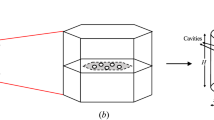Abstract
It is hypothesized that for ductile austenitic stainless steels exposed to boiling MgCl2 solution, the relevant crack propagation mechanism is slip dissolution. This model relates crack advance to oxidation or anodic dissolution that occurs on the bare surface that is created when a thermo-dynamically stable, protective film at the crack tip mechanically ruptured. Based on the model of slip-bare metal dissolution repassivation and crack-tip strain analysis, a theoretical equation of stress-corrosion crack growth rate as a function of crack-tip strain rate and potential for 321 stainless steel in boiling 42 pct MgCl2 solution is proposed. The theoretical prediction shows that when the crack-tip strain rate changes from 10−4 to 10−2 s−1 the crack propagation rate changes from 0.01 to 3 mm/h at the free corrosion potential (−0.35 VSCE). If the crack-tip strain rate is above 10−2/s, the crack propagation rate should correspond to the upper bound determined by the maximum metal dissolution rate. When the crack-tip rate is below 10−4/s, the crack propagation rate is below 0.01 mm/h. The slip-step dissolution model predicted that there exists a critical potentialE c, above which the crack propagation rate is independent on potential, but below which the crack propagation rate decreased with decreasing potential. The theoretical prediction has been verified by slow strain rate tests of 321 stainless steel under potential control (above −0.35 VSCE) in 42 pct MgCl2 solution.
Similar content being viewed by others
References
R.C. Newman and A. Mehta:Environment-Induced Cracking of Metals, NACE, Houston, TX, 1990, p. 489.
K.J. Kessler and H. Kaesche:Electrochemical Corrosion Testing, ASTM STP 727, 1989, p. 84.
J.F. Rimbert and J. Pagetti:Corros. Sci., 1980, vol. 20, p. 189.
P.L. Andresen and D.J. Duquette:Corros. Sci., 1980, vol. 20, p. 211.
F. Mancia and A. Tamba:Corrosion, 1986, vol. 42 (6), p. 362.
P. Chung, A. Yoshitake, G. Cragnolino, and D.D. Macdonald:Corrosion, 1985, vol. 41 (3), p. 159.
L.F. Lin, G. Cragnolino, Z. Szklarska-Smialowska, and D.D. Macdonald:Corrosion, 1981, vol. 37 (11), p. 616.
R.N. Parkins:Corrosion, 1987, vol. 43 (3), p. 133.
G. Herbsleb and W. Schwenk:Corrosion, 1985, vol. 41 (8), p. 431.
R.N. Parkins:Br. Corros. J., 1972, vol. 7 (2), p. 154.
J.M. Sutcliffe, R.R. Fessier, W.K. Boyd, and R.N. Parkins:Corrosion, 1972, vol. 28 (7), p. 313.
F.P. Ford and P.L. Andresen:Parkins Symposium on Fundamental Aspects of Stress Corrosion Cracking, S.M. Bruemmer, eds., TMS, Warrendale, PA, 1991, p. 43.
J. Congletob, T. Shoji, and R.N. Parkins:Corros. Sci., 1985, vol. 25, p. 633.
T. Nakayama and M. Takano:Corrosion, 1986, vol. 42 (1), p. 10.
R.W. Steahie:The Theory of Stress Corrosion Cracking, J.C. Scully, ed., North Atlantic Treaty Organization, Brussels, 1971, p. 223.
R.W. Steahie:Stress Corrosion Cracking and Hydrogen Embrittlement of Iron Base Alloys, NACE, Houston, TX, 1977, p. 180.
P.L. Andresen and P.F.P. Ford:Mater. Sci. Eng., 1988, vol. A103, p. 167.
F.P. Ford:Corrosion Processes, R.N. Parkins, ed., Applied Science Publishers, London, 1982.
R.N. Parkins:Proc. 3rd Int. Conf. on Mechanical Behavior of Materials, K.J. Miller and R.F. Smith, eds., Elmsview, NY, Pergamon Press, New York, NY, 1979, vol. 1, pp. 139–64.
T.R. Beck:Corrosion 30, 1974, vol. 11, p. 408.
H.L. Logan:J. Nat. Bur. Stand., 1952, vol. 48, p. 99.
R.W. Staehle:Theory of Stress Corrosion Cracking, J.C. Scully, ed., NATO, Brussels, 1971, p. 223.
J.C. Scully:Corros. Sci., 1968, vol. 8, p. 771.
S.J. Hudak: Ph.D. Dissertation, Lehigh University, Bethlehem, PA, 1988.
F.P. Ford and P.L. Andresen:Advances in Fracture Research, Pergamon Press, Oxford, 1989.
D.L. Li, R.Z. Zhu, and W.Q. Zhang:Sci. China, 1989, vol. 32 (10), pp. 1251–59.
F.P. Ford, G.T. Burstein, and T.P. Hoar:J. Electrochem. Soc, 1980, vol. 127 (6), pp. 1325–31.
G.T. Burstein and H. Davies:J. Electrochem. Soc, 1981, vol. 128 (1), pp. 33–39.
G.T. Burstein and G.W. Ashley:Corrosion, 1983, vol. 39 (6), pp. 241–47.
G.T. Burstein and G.W. Ashley:Corrosion, 1984, vol. 40 (3), pp. 110–15.
G.T. Burstein and R.C. Newman:Electrochem. Acta, 1980, vol. 25, pp. 1009–13.
G.T. Burstein and P.I. Marshall:Corros. Sci., 1983, vol. 23 (2), pp. 125–37.
I. Maier and J.R. Galvele:Corrosion, 1980, vol. 36 (2), p. 60.
J.R. Galvele, S.B. de Wexler, and I. Gardiazabal:Corrosion, 1975, vol. 31, p. 352.
D. Li and X. Mao:Metall. Trans. A, 1992, vol. 23A, p. 2873.
R.N. Parkins:Parkins Symposium on Fundamental Aspects of Stress Corrosion Cracking, S.M. Bruemmer, E.I. Meletis, R.H. Jones, W.W. Gerberich, F.P. Ford, and R.W. Staehle, eds., TMS, Warrendale, PA, 1991, p. 3.
H. Ohtuka and A. Ikushima:Mechanical Behaviour, W.G. Moffate and J. Wulff, eds., New York, NY, 1965, p. 92.
D. Li and Z.X. Huang:J. Chin. Soc. Corros. Protect., 1986, vol. 6 (2), p. 177.
A.J. Russel and D. Tromans:Metall Trans. A, 1981, vol. 12A, p. 613.
Author information
Authors and Affiliations
Rights and permissions
About this article
Cite this article
Mao, X., Li, D. Slip-step dissolution and micromechanical analysis to model stress-corrosion crack growth of type 321 stainless steel in boiling mgci2 . Metall Mater Trans A 26, 641–646 (1995). https://doi.org/10.1007/BF02663913
Received:
Issue Date:
DOI: https://doi.org/10.1007/BF02663913




